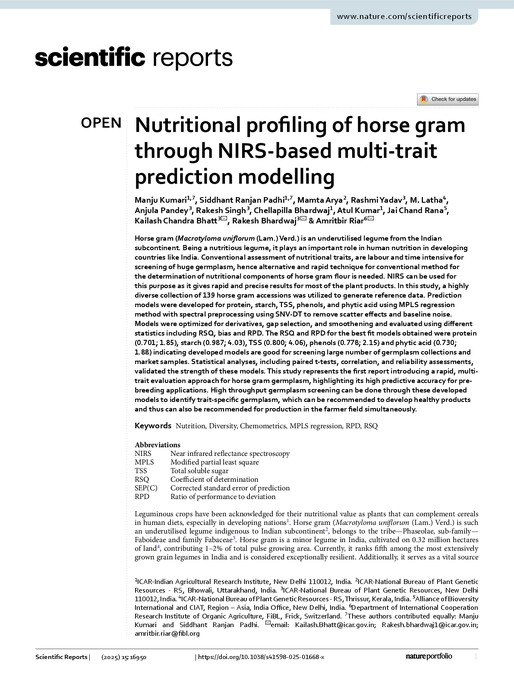Horse gram ( Macrotyloma uniflorum (Lam.) Verd.) is an underutilised legume from the Indian subcontinent. Being a nutritious legume, it plays an important role in human nutrition in developing countries like India. Conventional assessment of nutritional traits, are labour and time intensive for screening of huge germplasm, hence alternative and rapid technique for conventional method for the determination of nutritional components of horse gram flour is needed. NIRS can be used for this purpose as it gives rapid and precise results for most of the plant products. In this study, a highly diverse collection of 139 horse gram accessions was utilized to generate reference data. Prediction models were developed for protein, starch, TSS, phenols, and phytic acid using MPLS regression method with spectral preprocessing using SNV-DT to remove scatter effects and baseline noise. Models were optimized for derivatives, gap selection, and smoothening and evaluated using different statistics including RSQ, bias and RPD. The RSQ and RPD for the best fit models obtained were protein (0.701; 1.85), starch (0.987; 4.03), TSS (0.800; 4.06), phenols (0.778; 2.15) and phytic acid (0.730; 1.88) indicating developed models are good for screening large number of germplasm collections and market samples. Statistical analyses, including paired t-tests, correlation, and reliability assessments, validated the strength of these models. This study represents the first report introducing a rapid, multi-trait evaluation approach for horse gram germplasm, highlighting its high predictive accuracy for pre-breeding applications. High throughput germplasm screening can be done through these developed models to identify trait-specific germplasm, which can be recommended to develop healthy products and thus can also be recommended for production in the farmer field simultaneously.
Kumari, M.; Padhi, S.R.; Arya, M.; Yadav, R.; Latha, M.; Pandey, A.; Singh, R.K.; Bhardwaj, C.; Kumar, A.; Rana, J.C.; Bhatt, K.C.; Bhardwaj, R.; Riar, A.

